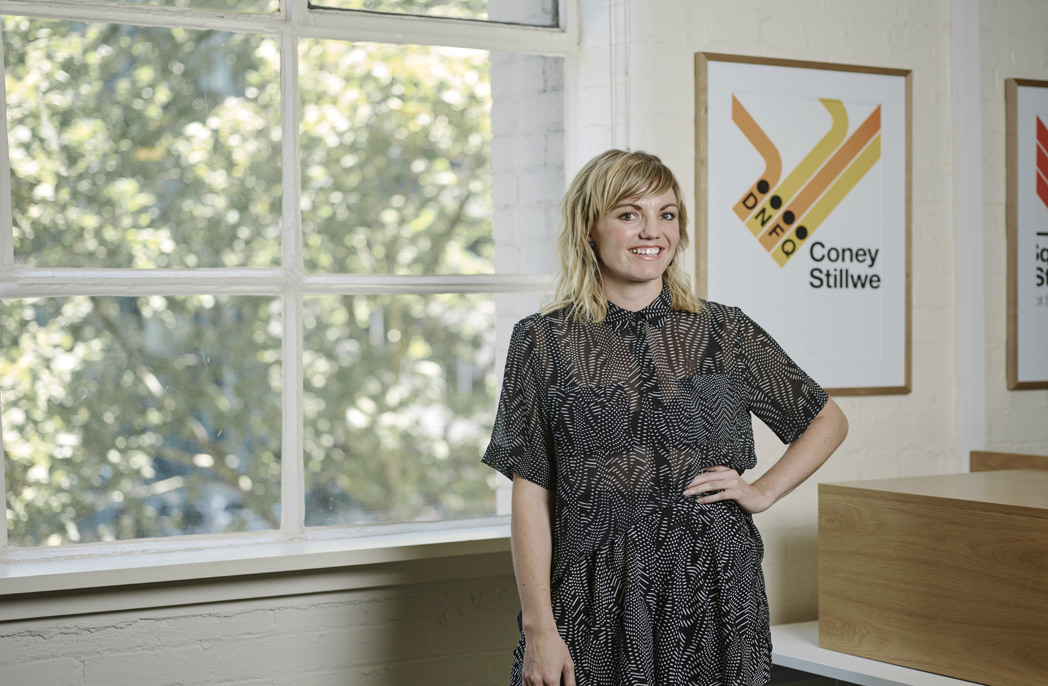
More than just a bathroom sign: how design can become more inclusive
More than just a bathroom sign: how design can become more inclusive
Share
Signs reflect society’s values and convey meaning to the people who use them. In some cases, our signs lag behind and conflict with our values. Dr Kate Luckins, research and communications strategist at Büro North, tells ADR how design has the power to drive inclusivity.
In the last two years, there has been heated global debate about gendered bathrooms and who has the right to use them. Our understanding of the need for inclusive and accessible design has evolved and our approach to public bathroom design needs to change accordingly. We share a responsibility to design for equality and we have found a way to do this.
At Büro North, we create richer human experiences in the built environment. We help organisations design how spaces are used by people. One aspect of what we do is wayfinding and signage design. As our clients are asking for universal design and inclusive signs, we have undertaken in-depth research to inform our design response and shift the conversation into action.
We have interviewed leading researchers and advocates in this field including Ro Allen, Victorian commissioner for gender and sexuality and Nick Morris, universal design and accessibility consultant.
How signs can exclude people
The pictogram of a male or female often used for bathroom signs does not represent all people and leads some people to feel fearful and excluded. As architecture academic Simona Castricum explains, “the familiar signage silhouettes of male and female that mark our public bathrooms reduce gender down to our bodies and clothing. Not only do they reinforce outdated gender stereotypes, they erase non-binary people.”
The gendered bathroom construct is a relatively recent phenomenon. It wasn’t until the 19th Century that public toilets were divided by gender in the United States to ‘protect women’s virtue.’ This was a mistake. In the modern world, gender-segregated bathrooms create problems of exclusion.
In a similar vain, the wheelchair pictogram is not inclusive of all people living with a disability. Ninety-three percent of people with disabilities don’t use a wheelchair according to McCann London. People who use accessible facilities also include the elderly, those who quickly become fatigued and parents with prams according to Nick Morris, universal design and accessibility consultant.
People with invisible disabilities are vulnerable to having their rights to accessible facilities challenged or denied. “In some instances, someone with an invisible disability might be mistaken for an able-bodied person and as a result, be subjected to abuse and unfair judgement as to why they’re using an accessible facility” says Liam Riddler, who suffers Crohn’s disease and founded McCann’s Visibility93 to address this problem. While disability is narrowly portrayed as being in a wheelchair, perceptions about disability are often inaccurate and unfair.
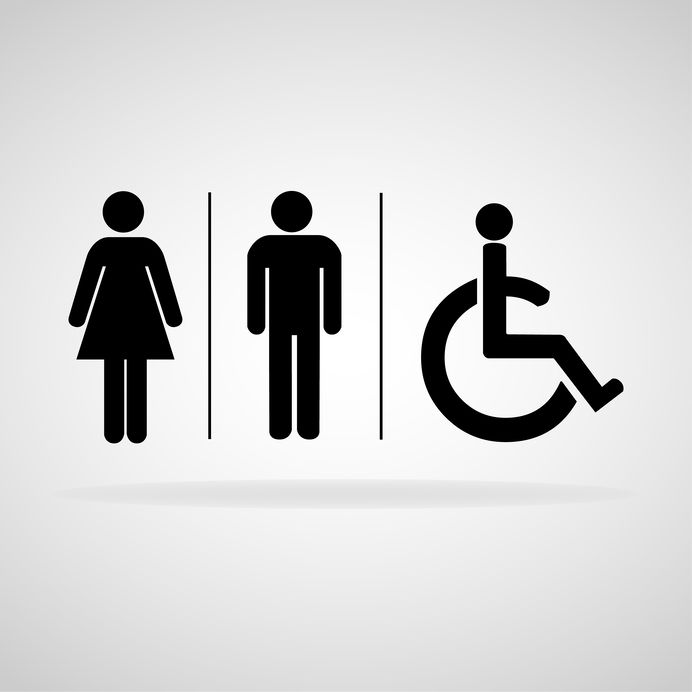
123RF’s yayha © 123rf.com
The bathroom battle thus far…
In 2016, North Carolina enacted a law to force transgender people to use the gendered bathrooms that align with their birth gender. Under the Obama administration, The White House adopted a contrasting position to allow individuals to use the bathroom that aligns with their gender identity.
In spite of this progress however, numerous states blocked this directive causing widespread protests across the United States and around the globe. Those opposing inclusive bathroom bills propagate the myth that some men will pretend to be transgender to prey on women and children.
However, international studies have shown that the majority of harassment and violence in bathrooms is experienced by trans, non-binary and gender diverse people according to Ro Allen, Victorian Commissioner for Gender and Sexuality. In a recent ABC news article, Mildura transgender woman Aurora explained, “half the time I won’t leave the house because it’s too hard to find a toilet that I feel safe in using.”
She fears judgement and violence in public bathrooms having been threatened many times. In Australia, our federal laws prohibit discrimination on the basis of sexual identification according to law professor Olivia Rundle.
Australia has taken an inclusive approach to bathroom use within schools where students are empowered to make their own choices. In South Australia, a policy for transgender and intersex students supports them using the bathroom based on the gender they identify with. The Commonwealth public service is prioritising gender-neutral bathrooms in Canberra to foster greater inclusivity.
Having the right policies and codes is a first step. Ensuring that those are integrated into every day behaviours is another thing altogether. According to disability access consultant Tanisha Cowell, all-gender facilities are technically non-compliant with the Building Code of Australia. It is stipulated that ambulant toilet facilities must be provided for males and females however Cowell encourages deviation from this rule.
Defining the language of inclusion
Signs can exclude but so can the language we use to describe them. Therefore it is essential that we define a language of inclusion that aligns with society’s values. Inclusive language ensures everyone is treated with respect and welcomed into public spaces.
The ‘Australian Inclusive Language Guide’ defines inclusive language to be free from words or tones that reflect prejudice, discrimination or stereotypes. When undertaking this research, we found a range of common terms used to describe bathroom users.
The term ‘unisex’ received a mixed response and was considered by some outdated as it presumes that users identify with a specific gender binary of male or female. There is a significant population that identify as non-binary and find the term ‘unisex’ alienating.
According to Ro Allen, Victorian commissioner for gender and sexuality, the terms ‘all gender’ or ‘gender neutral’ are preferable as they include people of all genders, including those outside the male/female binary. The International Gender Design Network agrees. People with Disability Australia (PWDA) state that “people with disability spend a lot of time being described in ways which are disempowering, discriminatory, degrading and offensive.”
Negative terms that imply that people living with disability are ‘victims’ who ‘suffer’ reinforces harmful stereotypes that they should be pitied. This is not the case. ‘Just as people should not be referred to in racially or sexually derogatory terms, people with disability should no longer be referred to in ways that categorise their lives in a simplistic, one-dimensional manner’ according to PWDA.
The current view of disability acknowledges a person has an impairment or medical condition, but that the disabling barriers exist within society rather than with the individual. For instance, negative attitudes or inaccessible buildings prevent people with disability from fully participating in all aspects of community life. To be inclusive, Morris highlights the need to focus on creating accessible environments.
He favours the term designing for ‘accessibility’ rather than for disability as it is respectful and accurately reflects the broader range of people who use accessible facilities.
An inclusive design response?
In response to the bathroom bill controversy in the States, Fast Company called for a design response and featured gender-inclusive bathroom signs. The design responses varied from focusing on the skeleton we all have in common, creating a pictogram depicting a third gender or opting out of the debate altogether.

Designed by Geoff Cook and Min Lew, partners, Base Design’s New York Office

Designed by Jonathan Notaro, Executive creative director & partner, Brand New School
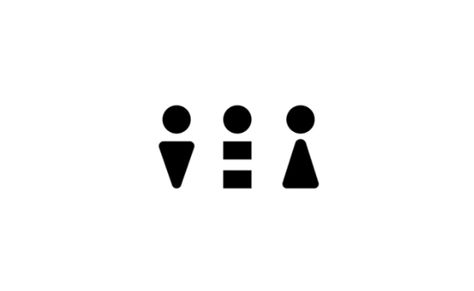
Designed by Vivi Feng, designer, Siegel+Gale
While the design intention was on point, these designs may only rouse new concerns where they comment on gender. These signs may also struggle to communicate in context. If you saw a skeleton on a door, would you want to open it? Herein lies the challenge: bathroom signs need to reflect our progressive attitude towards gender while clearly communicating to all users.
While many are critical of the traditional gendered bathroom pictograms, it is hard to dispute that they are widely recognised. As Morris confirms, the wheelchair pictogram is recognised by everyone looking for an accessible route or amenity. If new pictograms are developed, he says there will be a delay between making the change and people coming to recognise them.
Back when the bathroom-battle emerged in the media, our design team developed concepts for an inclusive bathroom sign. We removed gender from the equation and focused on the functionality of the bathroom.
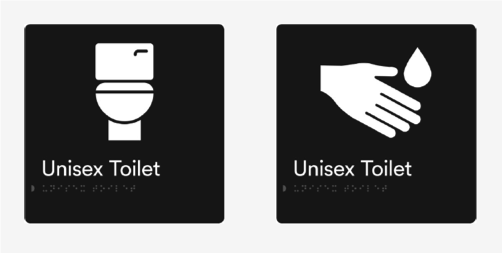
Büro North concept designs 2017
From our initial surveying, the toilet sign received the most support. Since then, we have found many others have come to the same conclusion. Equal Access Australia produce and sell a similar all-gender toilet sign which Cowell says has been well received.
Morris favours a more dynamic pictogram that shows a person in a wheelchair in motion. He rejects the connotation he is wheelchair bound as he transitions from between a car, couch and wheelchair daily. Project Visibility 93 focuses on being inclusive of people who suffer with invisible disabilities by developing a more comprehensive range of pictograms.
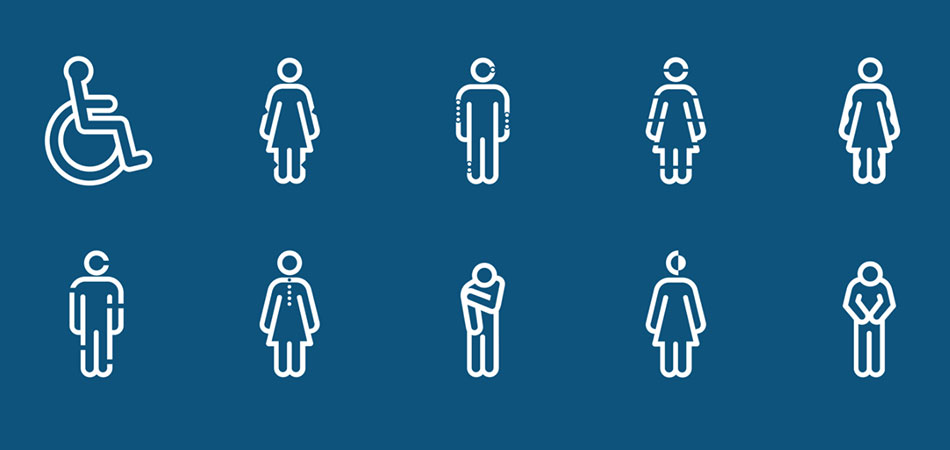
Project Visibility 93
They are not proposing these replace the iconic wheelchair pictogram, but rather seek to change perceptions and advocate for the fair treatment of people with invisible disabilities.
Rethinking bathroom design
There are many situations where all-gender bathrooms will help people, such as mothers of young boys who complain about going to the women’s bathroom. It will help when carers of people with mobility impairment are of differing genders.
It will help people who don’t conform to gender binaries. All-gender bathrooms are especially important to those who are in the process of transitioning as you don’t know when to transition traditionally gendered toilets.
But how do other cultural groups feel about all gender bathrooms? Muslim communities have beliefs about modesty, gender, and gender segregation .
“As a Muslim in North America, there are few spaces where I can comfortably wash-up before each of the five daily prayers,” explains blogger Miss Muslim NYC. When working with a leading Australian University, there were nine students surveyed who identified as non-binary and thousands of Muslim students.
By focusing on gender inclusion and promoting all-gender bathrooms, we potentially exclude another cultural group, therefore shift the problem. Over the years, bathroom design has evolved to include greater functionality including baby change tables, sharps bins, showers for cyclists and even hoists to ensure for those who require significant assistance. Ambulant accessible toilets are a new and increasingly popular concept.
These are wider cubicles with raised toilets and side grab rails for people with mobility impairments. As Morris explains, “we need people of all abilities to use to bathrooms that reflect their needs as much as their gender.”
To achieve this, we need much more than just a new accessible, all-gender bathroom sign. We need to rethink the whole public bathroom design. To be truly inclusive, we need to design accessible, all-gender bathrooms with wider, closed stalls with private wash basins. There are several examples that serve as a precedent for this approach including aeroplane bathrooms, domestic bathrooms and single-use cubicle bathrooms often found in cafes.
Not only is this approach inclusive, there are several other advantages. Women waste countless hours over their lifetime of waiting longer in line than men to use the bathroom. According to a recent study, women wait an average of 2 minutes and 18 seconds and men wait 40 seconds for the bathroom. When all genders share the same toilets, the wait time becomes equitable. For new buildings, taking the all-gender approach means the bathroom layouts become more flexible.
By maintaining the status quo, we continue to perpetuate outdated notions of gender and disability that are a disservice to many members of our community. As a progressive, multi-cultural society, we need our bathrooms and signs to accurately reflect and include all users.
Legislation, building codes and policies need be updated and drive implementation accordingly. We need to move beyond the divisive bathroom debate and implement inclusive design. We can all do better.
You Might also Like
